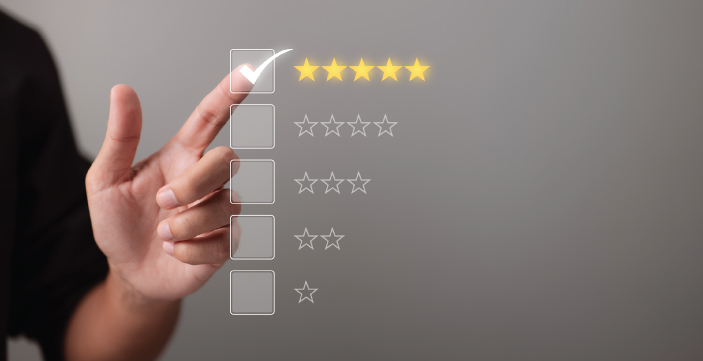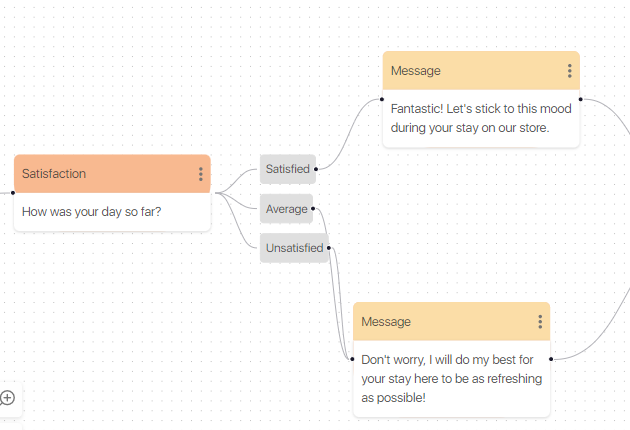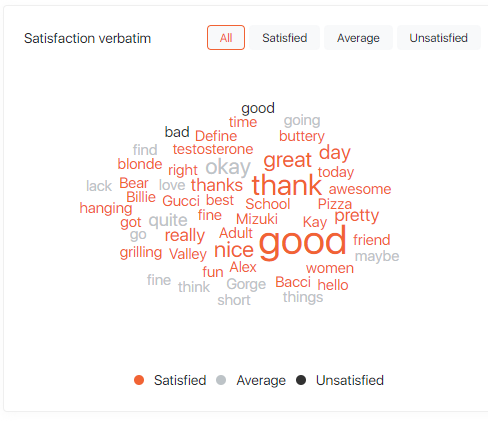Introduction
This article will show how a voice survey brings the understanding of your customer to a new level.
To get there we will go through:
- Traditional survey and their limitation
- The benefit of voice surveys and how they enable a better understanding of the customer
- What the voice data generated by these surveys is and why this data is so valuable.
Let’s dive in!
Voice surveys fundamentals
Traditional forms of surveys?
A survey is a research method to gather information about a specific topic. For this, you ask people to answer a set of questions that you’ve already prepared.
Analyzing survey results empowers you to make the best business decision or understand a particular situation.
Surveys can take several forms:
- Online/offline
- Focus group
- Paper survey
- Telephone survey
- Much more

What are the limitations?
Each type of survey has its own limitations. That’s why, to get the most accurate results possible, the best thing to do is to combine several types of surveys to get the best understanding possible.
Let’s take a quick look at what the limitations of different types of surveys are.
Usually, most offline surveys are quite costly as they require more human and financial resources to be organized (in-person interview, focus group, paper survey, implementation of a scenario with actors and subjects)
Often, the main problem with online surveys is that people have too much time to think about their answers.
Don’t get me wrong, this can be a good thing for questions where the users need to reflect on their answers.
But it also makes you lose the authenticity and the spontaneity that you can have when you reply under pressure when facing someone or when you have a time limit.
What is a voice survey?
A voice survey is a survey where the questions are asked by an AI voice assistant and the respondent answers the questions by voice.
These responses are then analyzed by the speech to text technology that converts the spoken words into textual data.

This data is then well organized and ready to use for the one that needs it.
Voice survey : a new step in the understanding of your customer
Voice surveys provide several benefits compared to other types of surveys. It has the advantages of the online surveys while still having some benefits of the in-person surveys.
They are more scalable and have the benefit of being vocal, so it takes less time to listen to questions and reply to them.
Let’s take a deeper look at the benefits of voice surveys.
More natural and honest answers
When an AI asks you a question by voice you need to reply instantly because just after the question there is a time gap where it expects a reply and listens to your answer.
This means it has the benefit of an in-person survey where you don’t necessarily have time to prepare an answer and you have to reply with your instinct.
This leads to an honest reply as you give the first information that comes to your mind, and it makes the whole process more natural.
It feels like a normal conversation between two people.
More detailed and quicker process
Sometimes we are lazy!
We wouldn’t bother typing a detailed reply to a survey on our computer because it just takes way too much time.

With voice it’s different!
In the same amount of time, you communicate 5 times more information when you speak compared to when you write text. Voice survey is a quicker process, and it enables you to get much more information as people will be expanding the answers while putting less effort into the survey than if you’re doing the process in person.
No more compromise between the number of respondents and the detail of the answers!
You can have an unlimited number of respondents while still having the depth of answer that you want for your research.
This brings you much more detailed and accurate information about the topic you’re making the survey for and leads to a clearer understanding of the overall situation.
They save time, you save money
Of course, you will get a deeper understanding of your topic by interviewing each person for an hour in-depth.
Of course, it will be cheaper for you to just send out a paper form or to create a google form and send it to thousands of people.
But think about the people you’re going to be interviewing:
Do they want to spend 30-45 minutes in a room with you to answer your questions if you don’t pay them?
Do they want to bother sitting down and focusing on filling a long-form where they will have to read long questions and take 5 minutes just to reply in a few lines?
Now if you only have “yes-no” types of questions and boxes to tick, it can be quicker! forms are still a very good way to collect information.
But if you want to get in-depth information with little effort and for very little money, a voice survey is the best compromise.
On top of that, you can’t make any spelling mistakes with your voice! (I know there is one here, you get my point 
Creating your own voice survey
At this point, if you agree with my points, you might think: “Cool, but creating a voice survey is much more difficult than doing other types of surveys, isn’t it?”
It’s not!
With Vocads’ no-code platform creating a voice survey requires the same effort as creating a google form but you will get much more in-depth answers and quicker!

For your customers, voice surveys make a big difference!
They can answer your survey without staring at the screen and just lie down, listen and speak!
They can give more detailed answers faster and more easily. While putting in less effort they will provide more valuable answers!
Amazing right?
Here is how you can create a survey with Vocads.

How voice data creates gold for your company
All surveys generate data and business leaders have used it for dozens of years to push and improve their companies.
But we’ve seen above how voice data is more precious because it is more rich, spontaneous and accurate.
To make the most out of your voice surveys, it is essential to understand the types of questions allowed by voice technologies and how each of them leads to a different type of answer, and therefore data.
In the next few sections, we will take you through those different questions and how Vocads’ amazing dashboard displays their data for you.
We will then see why this data is so valuable.
(Vocads only collects data when the microphone is green, at any other moment nothing is recorded)
The different types of voice data
When asking questions in a survey, depending on the way you ask the data is going to be reflected differently.
Look at Google Form results
Oh, fantastic, at Vocads we did the same thing for voice surveys!
Through Vocads platform, you can create a voice survey with 4 types of questions and no coding knowledge at all (Vocads has a no-code platform). All of them will bring you different data.
The survey report will contain individual entries for each question with the question title, the replies, and the date of the replies.

Open questions
On top of having the transcript we mentioned above with all the individual replies, answers to an open question as summarized as verbatim.
Here’s an example: (the data is not necessarily relevant here because the number of replies is too small, but you get the idea)

The bigger the word, the more people have used it.
This compact visualization will provide you with valuable information on what people are asking the most or what they are suggesting.
Yes-no questions
For yes-no questions, you will see a pie chart of the response distribution:

Of course, our AI is more powerful than just understanding “yes” and “no” as answers.
If the person answers:
- Absolutely, definitely, let’s go… The AI will understand it as being a positive answer and will reflect it in the charts as a yes.
- Not really, I don’t want to, not now… The AI will understand it as being a negative answer and will reflect it as a no in the chart.
If you’re interested in the exact answers, they are available at the click of a button:

Satisfaction questions
Measuring the satisfaction of a customer’s life, thanks to an AI sounds exciting, right?
Well, satisfaction questions are an accurate way of measuring how your customer feels about something.
Satisfaction questions have 3 branches of answers:
- Satisfied
- Average
- Unsatisfied

Let’s take a look at how this is reflected in the data!
First, you will get a satisfaction rate chart

Then a verbatim where you can visualize the most frequent words

You can also filter the verbatim per branch

Finally, you will be able to see the evolution of the overall average satisfaction over time.

The satisfaction element doesn’t only give you insights on whether people are satisfied or not.
As you can see it’s much deeper than that!
You get to know why people are satisfied or unsatisfied with the exact words they say and how it evolves over time.
This can really help you make decision making in the long and short run.
Multichoice questions
Multichoice questions are pretty straightforward

You will get a response distribution chart with the percentages for each response.
You will also get a chart that shows how the responses evolve over time.

The other types of data
Yes, the data doesn’t stop here!
You’ll get general information about the survey:
- Number of answers
- All of the of questions
- Total number of days the campaign has been running
- Remaining day where the campaign will be running
- The number of responses over time.

Finally, you will get information about the bounce rate of the overall campaign and the bounce rate per question.

Why is voice data so valuable?
Okay, now you have the voice data all set up in beautiful manners
But what makes it so valuable?
First, with Vocads this data is yours and only yours. No one has access to it apart from you.
Even Vocads doesn’t have access to it!
That’s cool, right?
Secondly no worries, voice data doesn’t mean messy data!
It’s all already organized for you. It’s not because it’s voice that you need to organize it yourself. So it’s not going to cost you more money, effort or time.
Thirdly, this data is not based on any prediction model, it’s the words coming out of your customers’ mouths, it’s 100% authentic. You get to see exactly what the respondents reply word per word and if you want to organize the data yourself you can also do it as you have the exact transcription of the answer to each reply.
All this data will help you make better decisions and get a better understanding of any situation to bring your business to the next level!
My last advice:
Be Creative
This no-code platform gives you an opportunity to push your creativity limit, so play with it as much as you can!
If you want a demo for your site, click here to contact us!
Conclusion
Now I want your opinion!
Are you going to create a voice survey in the coming weeks?
If so, what will be the first question of your survey?
Or do you consider it not that better than other types of surveys?
If so, what is the reason? not enough stats? Do you think that the platform can’t do what you want to do?
Let us know in the comments and if you know anyone that needs some valuable and authentic data, drop them the link to this article!
If you’ve appreciated our work, the best you could do to spread the word would be to share this article on your social media!
